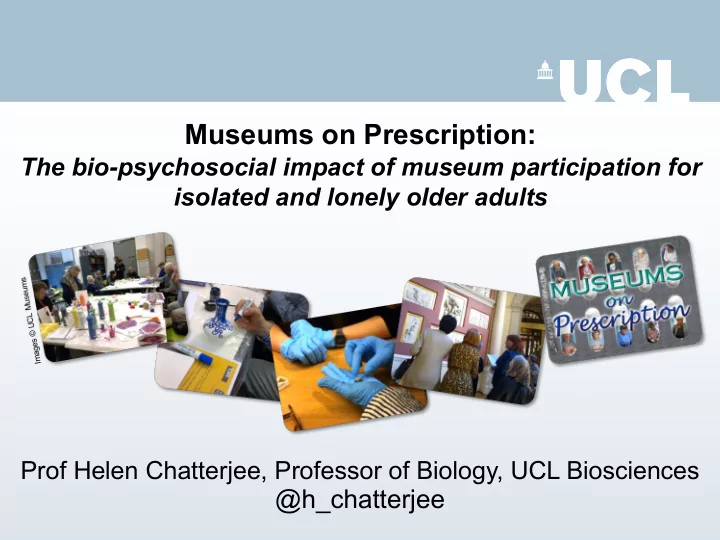

Museums on Prescription: The bio-psychosocial impact of museum participation for isolated and lonely older adults Prof Helen Chatterjee, Professor of Biology, UCL Biosciences @h_chatterjee
Museums on Prescription • 3 year AHRC funded research project (2014-2017) • Aim: to investigate the value of museum encounters in social prescribing • The research connected socially isolated, vulnerable and lonely older people , referred through local NHS and Local Authority Adult Social Care services, to partner museums in Central London and Kent. https://culturehealthresearch.wordpress.com/museums-on-prescription/
Phase 1: Review of social prescribing schemes Healthy Living Exercise Initiatives Referral • Examined databases, journal articles, Arts on Supported Prescription reports, grey literature and websites Referral Social • Reviewed over 100 UK schemes from the Enterprise Volunteering Books on Schemes last 25 years and examples from abroad Prescription Green Gyms • Explored variety of schemes: Education on Information Prescription Prescriptions Time Banks or ‘Signposting’ Chatterjee, H.J., et al. (2017) Non-clinical community interventions: a systematised review of social prescribing schemes. Arts & Health . DOI: http://dx.doi.org/10.1080/17533015.2017.1334002 Chatterjee, H. J., Polley, M. & Clayton, G. (2017) Social Prescribing: Community-based referrals in public health: Perspectives in Public Health . 138(1):18-19 DOI: https://doi.org/10.1177/1757913917736661
Phase 2: Evaluation of Museums on Prescription Participants (N=115) 7 x 10-week courses in partner museums: male 13 British Museum female 10 male 4 Beaney Museum female 12 male 6 Maidstone Museum female 12 male 3 Central St Martins female 8 male 9 Tunbridge Wells female 11 male 1 Postal Museum female 4 male 7 UCL Museums female 15 115 Total
Quantitative evaluation Beginning, middle and end of 10 weeks: UCL Museum Wellbeing Measure Warwick-Edinburgh Mental Wellbeing Scale Revised UCLA Loneliness Scale 3- and 6-month follow ups: Short Warwick-Edinburgh Mental Wellbeing Scale Three-item Loneliness Scale (Short UCLA)
Positive Wellbeing Umbrella Negative Wellbeing Umbrella Thomson, L. and Chatterjee, H.J. (2014) Journal of Applied Gerontology . 29: 155-179. Thomson, L. and Chatterjee, H. J.(2014) Journal of Applied Arts & Health. 5(1): 29–50.
Quantitative analysis UCL Wellbeing Measure Pre-post sessions 1, 5 & 10 Psychological wellbeing Error bars +/- 1 SD Thomson, Lockyer, Camic & Chatterjee (2018) Effects of a museum-based social prescription intervention on quantitative measures of psychological wellbeing in older adults. Perspectives in Public Health , 138(1), 28-38 http://dx.doi.org/10.1177/1757913917737563
R-UCLA WEMWBS Measures at start of Weeks 1, 5 & 10 Measures at start of Weeks 1, 5 & 10 Mental wellbeing over programme Social inclusion over programme Mean scores for individual museums Mean scores for individual museums
Qualitative evaluation Museum Passports (for participants) Facilitator Diaries Researcher Diaries End of programme interviews Follow up interviews at 3, 6 and 12 months Photos/videos
Qualitative analysis using Grounded Theory The student showed me I felt I learned some new a particular technique things and ‘re-learned’ the which I loved. We needed time to socialise things I had forgotten. I am but it was too interesting, happiest when learning - I felt didn’t want to take time out to engaged with the topic. socialise, not just making it a It got me out of the house ‘cup of tea’ session. and gave me a boost in the winter months. It has been a real privilege to have access to experts It was stimulating, it got and expert knowledge. I like to feel the texture of the my brain working. materials and the objects. Knowledge is useful, it’s It got me doing different something you didn’t things – things I had never I was pleased to know before you went. thought about doing before. see a bit of history. Todd, C., Camic, P. M., Lockyer, B., Thomson, L. J. & Chatteree, H. J. (2017). Museum programs for socially isolated older adults: Understanding what works. Health & Place . doi: 10.1016/j.healthplace.2017.08.005
Qualitative thematic analysis § Sense of belonging § Improved quality of life § Renewed interest in learning § Acquisition of new skills § Something to look forward to § Increased social activity § Increased creative activity § Continued visits to museums § Healthier lifestyle changes https://culturehealthresearch.wordpress.com/museums-on-prescription/
Museums on Prescription project team: Prof. Helen J Chatterjee (PI) & Dr Linda J Thomson, University College London; Prof. Paul M Camic (Co-I) & Dr Bridget Lockyer, Canterbury Christ Church University, Kent. Thanks to our funders + all of our partners : Email h.chatterjee@ucl.ac.uk Web https://culturehealthresearch.wordpress.com/museums-on-prescription /
Recommend
More recommend